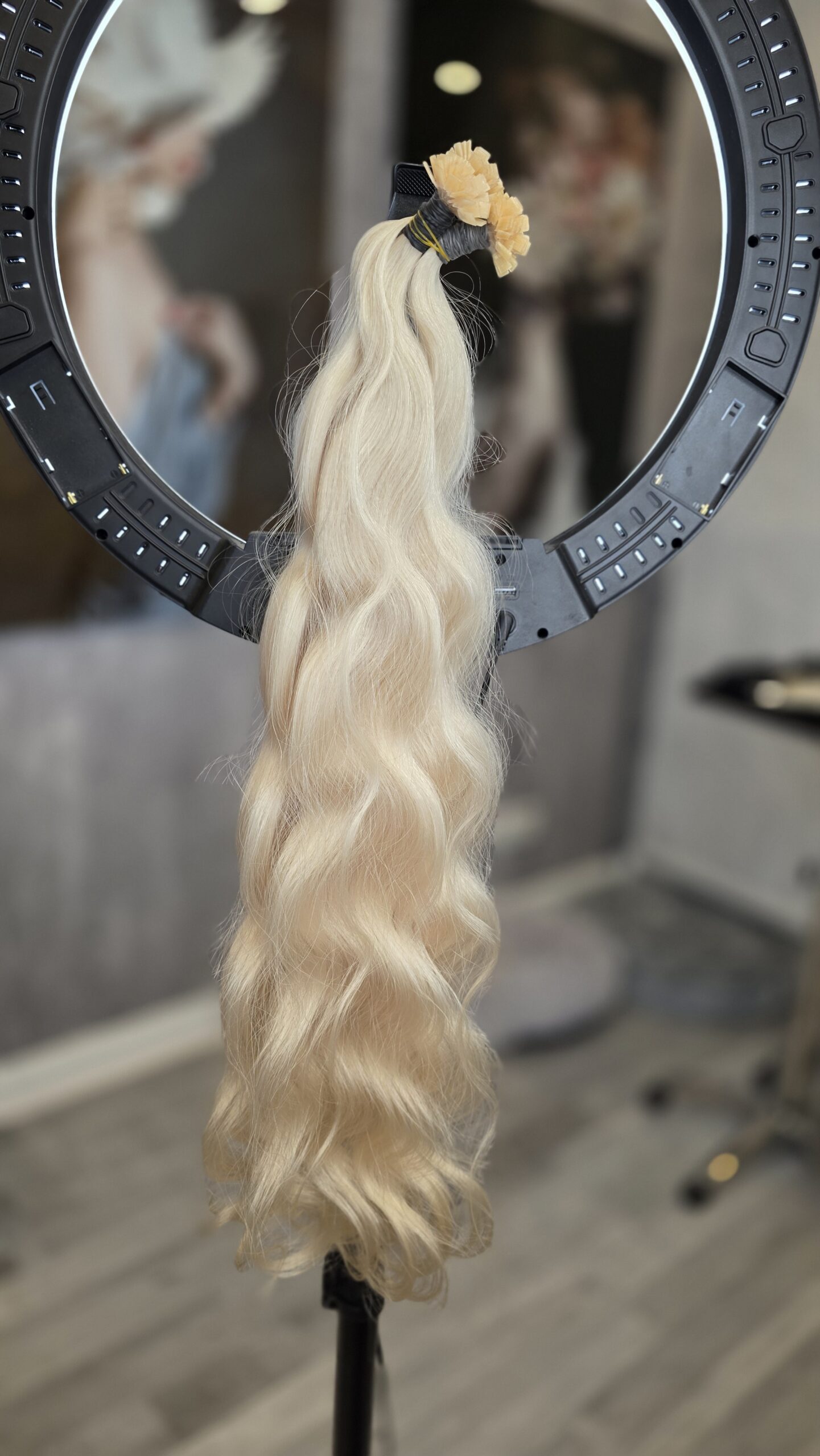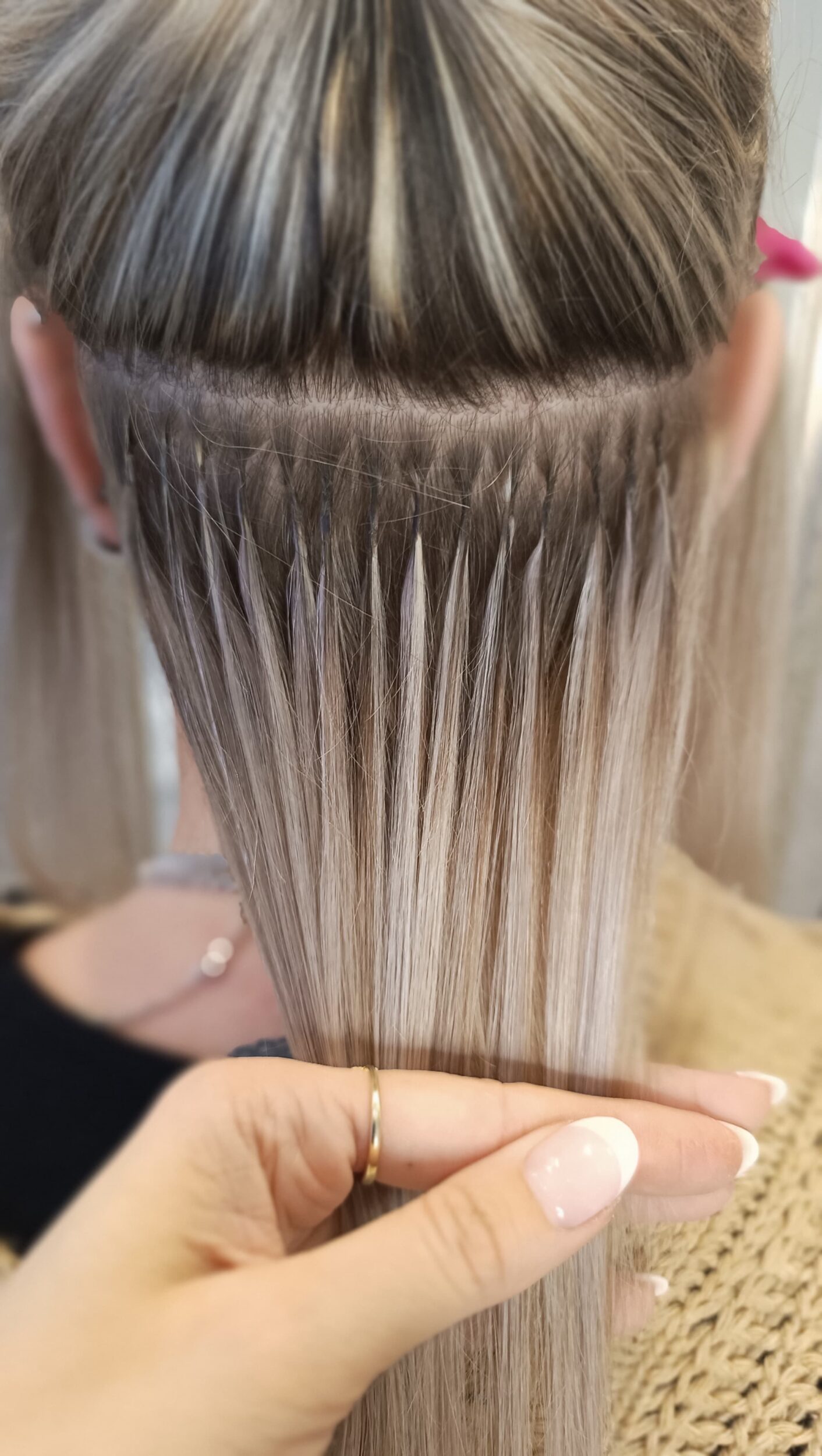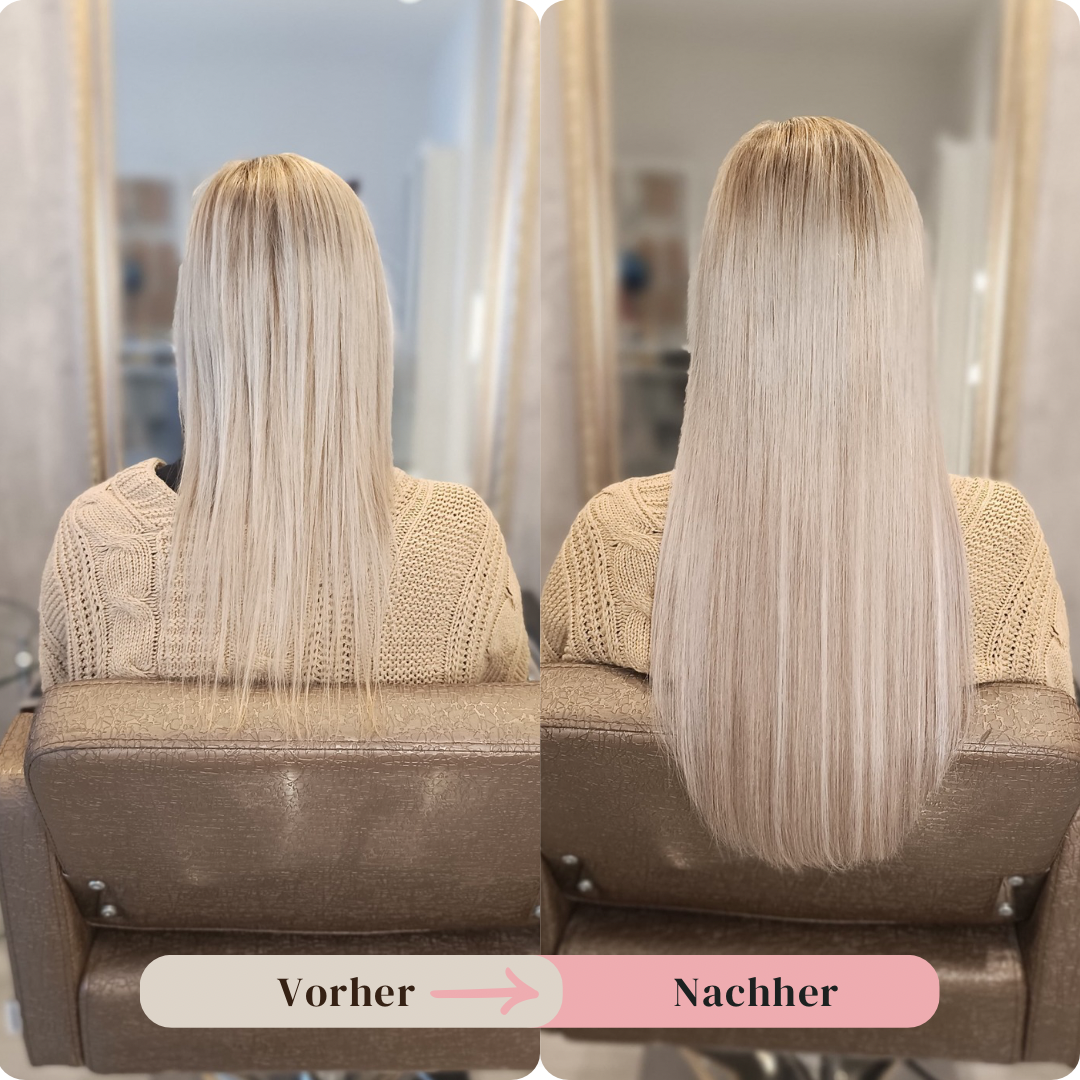Blog
Hair extensions for thin hair: how to do it without damage

Anyone with fine or thin hair knows the desire for more fullness and length only too well. Extensions seem to be the perfect solution, but at the same time doubts arise: Will a hair extension even hold with my hair texture? Will it make my hair even thinner or damage it? These concerns are justified, but with the right technique and care, it is possible to have thin hair extensions without damaging your own hair.
Why thin hair needs special attention
Fine hair is fundamentally different from thicker hair. The individual strands of hair have a smaller diameter and are therefore more sensitive. Hair density is also often lower, meaning that fewer hairs grow per square centimetre on the scalp. This combination makes fine hair more susceptible to damage.
If extensions are not fitted correctly, this can lead to several problems. The extra weight can overload the hair roots, leading to premature hair loss. In addition, fine hair is more prone to breakage, especially in the areas where the extensions are attached. In the worst case, visible bald patches or broken hair can occur.
However, these risks do not mean that people with thin hair have to do without extensions. It simply means that the choice of method and professional application are even more important than with thick hair.

The challenges of thin hair extensions
Before we turn to the solutions, it is worth understanding the specific challenges. Fine hair has less strength. What works fine for thick hair can be too much for thin hair. Every extension exerts a certain amount of tension on the hair root, and if this tension is too strong, the body reacts with hair loss.
Another problem is visibility. Bonding points are more difficult to hide in thin hair. Large, chunky bonds or wide strips of tape can show through or stand out, especially when the hair is pinned up or in certain lighting conditions.
Care also becomes more demanding. Fine hair tangles more easily, especially at the transitions between your own hair and extensions. At the same time, it tolerates aggressive Care products or too frequent washing worse than robust hair.
Psychology also plays a role. Many women with thin hair are already insecure about their hair. The fear of losing even more hair through extensions is real and understandable. This is why trustworthy counselling and a gentle method are so important.
Which methods are suitable for thin hair?
Not all hair extension techniques are equally suitable for fine hair. Here is an overview of the different options:
Nano-Bondings are often the best choice for very fine hair. These tiny connectors are about the size of a grain of rice and weigh only a fraction of conventional bonds. Instead of a few, heavy strands, many small strands are used, which distributes the weight evenly and does not overload any individual hair root. The nano-bondings are practically invisible and noticeable, even on very thin hair.
Micro-bondings are slightly larger than nano-bondings, but still significantly smaller than classic bondings. They are well suited to hair that can be categorised as fine to normal. Application is slightly quicker than with nano-bondings, which can also be reflected in the price. For medium-fine hair, they are often a good balance between gentle and economical.
Tape extensions can work on thin hair, but have certain limitations. The thin adhesive strips are generally gentle, but can be visible on very fine hair. They also stick flat to the head, which sometimes looks less natural than spot bonding. When choosing Tape extensions For thin hair, particularly thin, high-quality tapes should be used.
Methods to avoidSeverity Clip-in extensions with large clips and traditional weaving techniques with tight braids are usually too stressful for fine hair. These methods exert too much pressure on the sensitive hair roots.
Bonding extensions for thin hair: the gentle technique
Bonding extensions for thin hair have proven to be particularly gentle when used correctly. With this method, individual strands are attached to the patient's own hair with small keratin bonds. The keratin used is a natural protein that is also found in human hair.
The great advantage of the bonding technique is its flexibility. The bonding adapts to the natural movements of the hair and does not create rigid connection points where the hair could easily break. Bonding extensions can also be highly customised. The stylist can determine exactly how many strands are placed where to achieve an optimal result.
With thin hair, it is particularly important not to use too many extensions at once. Less is often more here. It is better to use fewer strands that are gentle on your own hair than too many that overload it. An experienced specialist will weigh up exactly how many strands your hair can bear without being damaged.
The quality of the extensions also plays a decisive role. High-quality human hair is lighter and integrates more naturally into your own hair than inferior material. It may be tempting to go for cheaper options, but with thin hair, investing in quality definitely pays off.
What you should address during the consultation
A detailed consultation is essential for thin hair. An experienced stylist should take the time to analyse your hair structure in detail. This is not just about the thickness of the individual hairs, but also about the density, elasticity and general condition of your hair.
Be honest about your expectations and your willingness to care for your hair. Extensions require effort, and even more so with thin hair. Ask specific questions:
- Which method is recommended for your hair type and why?
- How many strands are realistic without overloading your own hair?
- What length is feasible without the extensions becoming too heavy?
- How often are check-ups necessary?
- What happens if problems occur?
- What experience does the studio have with thin hair in particular?
A good studio will also tell you honestly if your hair is not suitable for extensions at the moment. This honesty may be disappointing, but it protects your own hair from damage. Sometimes it is better to improve the health of your hair first and then have extensions fitted.

The right care for thin hair
Even the best extensions can fail if the care is not right. You need to be particularly careful with thin hair with extensions. Here are the most important care tips:
Gentle brushing is the be-all and end-allUse a special extension brush with soft bristles AND with plastic rods, without beads on top. This is very important as a brush that is too soft will not comb through the hair properly. Always start at the ends and work your way up carefully. Never tug at knots, but gently loosen them with your fingers. Brush your hair at least twice a day to prevent tangles.
The right hair washWash your hair upright in the shower, not upside down. This prevents the extensions from getting tangled. Gently massage in the shampoo without rubbing. Use sulphate-, paraben- and silicone-free products, as these are gentle on the bonds and are also more suitable for fine hair. Do not wash daily, but only two to three times a week.
Moisture without weightingFine hair needs moisturising but does not tolerate heavy products. Light conditioners or leave-in sprays are ideal. Only apply them to the lengths and ends, not the roots, as otherwise the hair will look flat and greasy.
Never forget heat protectionWhen using styling tools, always protect your hair with a heat protection spray. Set your hairdryer, straightener or curling iron to medium temperatures. Fine hair does not need high heat levels and is quickly damaged by too much heat.
Sleeping with extensionsBraid your hair into a loose plait at night. This prevents tangles and protects the bonds. Some people also swear by silk pillowcases, which ensure less friction.
Regular checksHave your extensions checked every six to eight weeks. This way, small problems can be recognised early and rectified before they lead to major damage. These checks are particularly important for thin hair.
How long do extensions last with thin hair?
A common question is whether extensions last just as long with thin hair as with normal or thick hair. The answer depends on several factors.
With the right care and professional application, extensions can last four to six months, even with thin hair. However, more frequent check-ups may be necessary for fine hair. As your own hair often grows faster or the bondings become more visible with less hair, it may make sense to put them up earlier.
The quality of the extensions plays a major role here. High-quality extensions retain their structure for longer and can be put up several times. Inferior extensions can become straw-like after just a few months or the bonding can come loose.
Your lifestyle also influences the durability. Swimming in chlorinated or salt water should be completely avoided, as this can be very damaging to the hair. Intense sun exposure or very frequent styling with heat can also shorten the lifespan. If you have thin hair, you should treat your hair more gently anyway, which has a positive effect on its durability.
Costs for extensions for thin hair
The cost of extensions for thin hair varies depending on the method chosen, the number of strands and the quality of the extensions. As particularly fine techniques such as nano-bonding are often used for thin hair, the prices can be slightly higher than for standard extensions.
This investment may seem high at first, but remember: quality is particularly important for thin hair. Cheap extensions or improper application can damage your own hair to such an extent that repairing this damage ends up being significantly more expensive. In addition, high-quality extensions last longer and look better over the entire wearing period.
Alternatives for very sensitive hair
Sometimes the hair is so fine or damaged that even the gentlest permanent extensions are not recommended. In such cases, there are alternatives:
Clip-in extensions can be a good solution if you only occasionally want more volume or length. They are inserted as required and removed again in the evening so that your own hair can relax completely overnight. Look out for lightweight, high-quality versions with small, gentle clips.
Hair thickening instead of lengtheningSometimes it's not about length, but just more volume. In this case, hair thickening with a few strategically placed strands can be sufficient. This puts less strain on the hair than a full extension.
Volume powder and styling tricksWith the right products and blow-drying techniques, even fine hair can be made to look much fuller. A good hairdresser can show you how to get the most out of your own hair.
Treatments for hair healthSometimes it is better to invest in the health of your own hair first. Professional care treatments, nutritional supplements or medical clarification can help to strengthen the hair before extensions are used.
Success stories: Extensions despite thin hair
Many women with thin hair have already had positive experiences with extensions. The key to success lies in the right preparation, choosing an experienced studio and consistent care.
Typical success factors are: an honest assessment of the initial situation, the choice of a suitable, gentle method, realistic expectations regarding length and volume, consistent care and regular checks as well as the willingness to react quickly in the event of problems.
Women often report that extensions have increased their self-confidence enormously. They can finally wear hairstyles that were previously impossible. Their hair feels fuller and they no longer have to constantly worry about visible roots or flat hair.
Your path to full hair without compromise
Thin hair doesn't have to be an obstacle to a beautiful hair extension. With the right techniques, professional advice and careful care, you too can enjoy full, long hair without jeopardising your own hair.
At Haartick-Extensions, we specialise in hair extensions for fine and sensitive hair. We advise you in detail, analyse your hair structure and choose the right method for your needs. With our experience in bonding extensions for thin hair, we accompany you with regular check-ups on the way to your dream hair.
Arrange a consultation now and find out more →
Your hair deserves the best care, let's find the perfect solution for you together.

